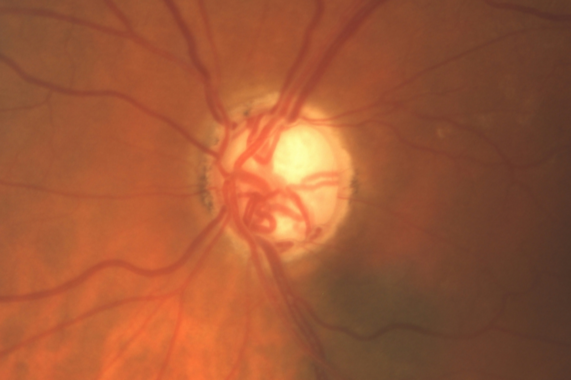Image: glaucomatous optic disc
What is glaucoma and who is affected by it?
Glaucoma is a group of eye conditions that damage the optic nerve and can lead to blindness. These eye diseases have in common that they cause optic neuropathy, which consists of the loss of retinal ganglion cells combined with an continous enlargement of the optic disc excavation - that is, the center of the optic disc, called the cup, becomes larger and the cup-to-disc ratio increases. This morphological change is important in distinguishing glaucoma from other types of optic neuropathies. Most often, glaucoma affects older people - meaning people over the age of fifty and especially over seventy years. But it can affect people of any age if the intraocular pressure is high enough.
What are the earliest signs of Glaucoma?
Early signs of glaucoma may be either the increased intraocular pressure already mentioned or the signs of glaucoma disease itself, i.e., impaired visual function. The second scenario is relatively more common, and the problem with this group is that when visual function is impaired, the disease is already well advanced. A patient has to lose about 50 percent of the ganglion cells to notice a dysfunction. This makes the disease very problematic and insidious. The most common scenario, however, is the case that patients consult an ophthalmologist due to another issue they have - such as an eye infection - and then glaucoma is diagnosed after further examination. So they actually have no symptoms of Glaucoma yet. In comparison it is relatively rare that a patient consults an ophthalmologist when already having visual defects due to glaucoma. However, as mentioned previously, if this is the case, then these patients already have significantly advanced glaucoma.
Why does it take so long for people affected to notice?
In order for us to survive, evolution has equipped humans with a large reserve of ganglion cells to keep the visual field functioning as long as possible. Evolutionarily, any animal with a problem in its visual field would not survive because it would not be able to see the predator coming from the side, above or below. Humans today still benefit from this abundance of ganglion cells, but this also means that we notice visual defects rather late. In addition, visual system tends to fill-in the blanks when they occur, which makes noticing them by patients in an early phase more unlikely.
What symptoms does a patient have when affected by Glaucoma?
Patients with glaucoma usually have orientation problems that are due to a visual field defect. There are different types of visual field defects, but in real life, a patient's symptoms depend more on the extent of the visual field defect and not so much on the type: the more severely a patient's visual field is impaired, the more likely the patient is to have orientation problems in everyday life.
What are risk factors for developing glaucoma?
Age is an important factor and high intraocular pressure. So it is important to know what can cause high intraocular pressure. Here we can divide the patients at risk into two categories: On the one hand, we have patients with metabolic syndrome, which is a combination of diabetes, hypertension and obesity. On the other hand, we have a very contrarian group of patients with what we now call Flammer syndrome, which is a dysregulation of blood supply that can manifest itself in many symptoms, such as cold hands and feet, and is often accompanied by low blood pressure. Hypothyroidism and sleep apnea are also risk factors for glaucoma.
How is Glaucoma treated?
The first and most important step is to decrease the intraocular pressure to reduce the loss of retinal ganglion cells. And then of course we have to address all the other mentioned risk factors: regulation of blood pressure and cholesterol levels are important as well as treating sleep apnea and the vascular dysregulation. This always depends on which symptoms a specific patient has.
Why is it important to conduct research in the field of glaucoma?
Up until now we have been treating glaucoma as mentioned before by regulating the intraocular pressure and addressing the other risk factors; but, my hopes are really high that one day researchers at IOB will find a way to improve the direct neuroprotective messaging so we can manage to signal the retinal ganglion cells to stay alive, that is, not to undergo programmed cell death.

